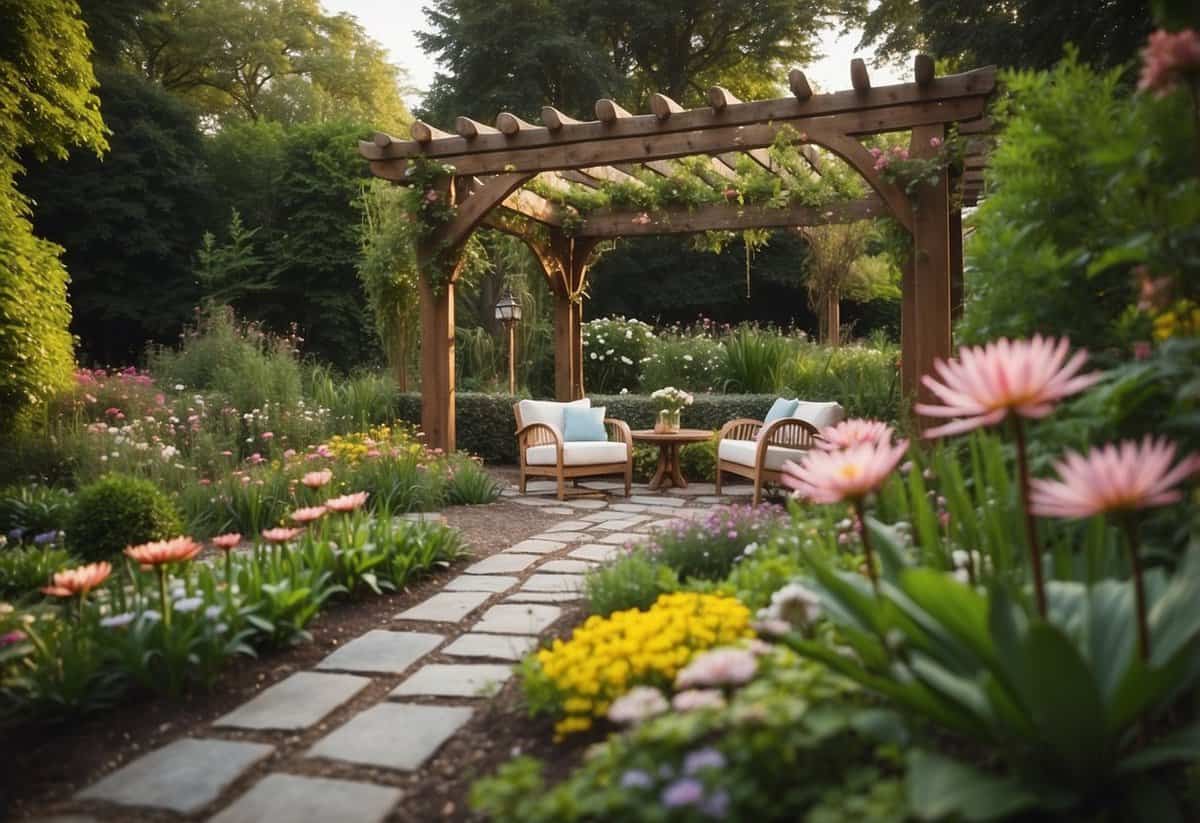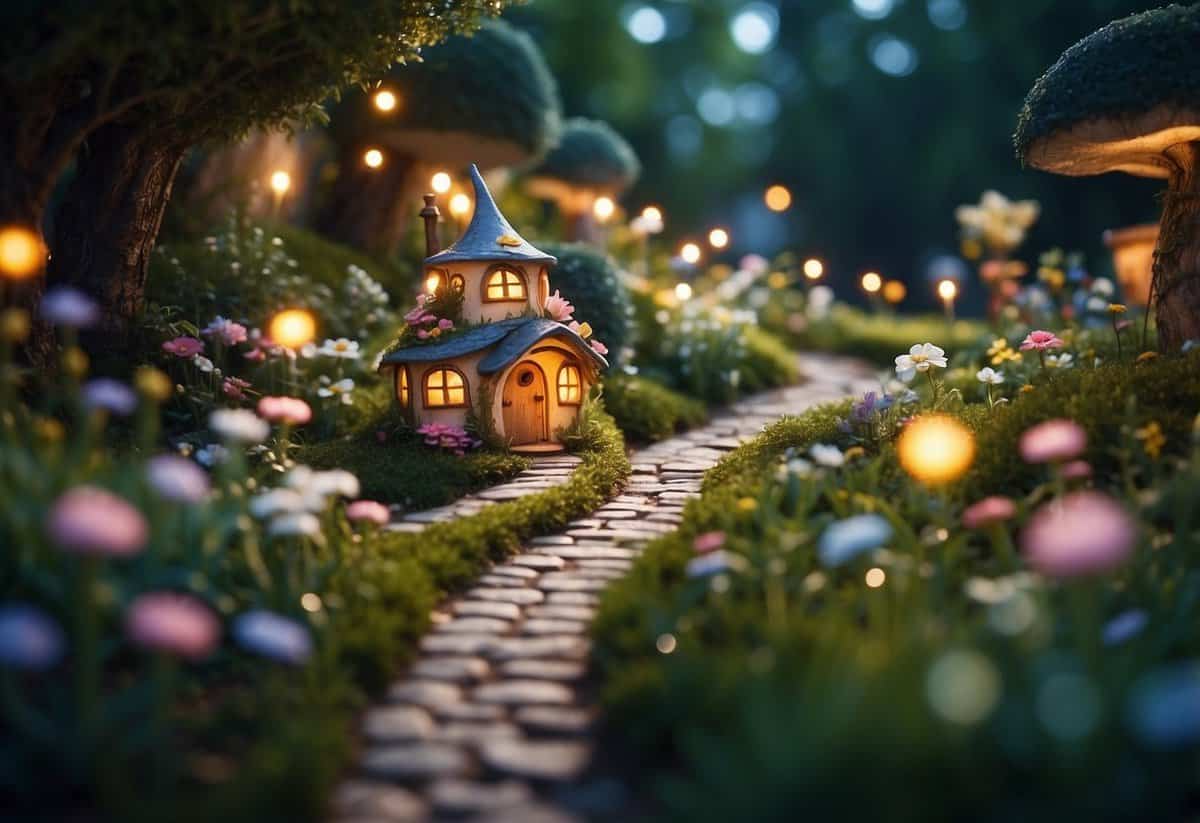Garden Ideas for Home: Transform Your Space into a Green Oasis
Creating a beautiful garden at home can transform your outdoor space into a relaxing oasis. Whether you have a small balcony, a spacious backyard, or anything in between, there are countless ways to make your garden special. Gardening not only enhances the beauty of your home but also provides a wonderful hobby that benefits your well-being.

From vibrant flowers to lush greenery, gardens can be tailored to your personal taste and lifestyle. Whether you prefer a low-maintenance setup or a detailed and expansive layout, there are options for everyone. Embrace the joy of gardening and watch as your home flourishes into a peaceful retreat.
1) Vertical Herb Garden

A vertical herb garden is perfect for small spaces. You can grow fresh herbs even if you don’t have a big yard. One idea is to use a pallet wood three-tiered herb garden.
Another option is transforming an Ikea bar cart into a mobile vertical herb garden, allowing you to move your herbs around for sunlight.
Using hanging shelves with Terra-Cotta pots is another creative approach. This setup is great for displaying your herbs in a stylish way.
2) Recycled Tire Planters

Recycled tire planters are a fantastic way to add a unique touch to your garden using old tires. To start, get a used tire and clean it thoroughly.
Once it’s dry, paint the tire with your favorite colors. You can use a single color or create fun patterns.
After painting, add drainage holes at the bottom. This helps your plants grow better. Fill the tire with quality potting mix and plant your favorite flowers or vegetables. For more info on creative ideas, check here.
3) Succulent Wall Frame

Creating a succulent wall frame is a great way to add some greenery to your living space. You can start by choosing an old picture frame and removing the glass and back.
Next, attach hardware cloth or chicken wire to the back of the frame. This will hold the soil in place.
Once the wire is secure, add potting soil. Use your hands to push the soil through the openings, making sure it’s evenly distributed.
Now, it’s time to add your succulents. Choose a variety of shapes and colors to create a beautiful mosaic. Place them securely into the soil and enjoy your new wall art!
4) Fairy Garden Path

Creating a fairy garden path is a delightful way to add charm to your outdoor space.
Use tiny stones or pebbles to form the path. This gives a natural, earthy look.
You can also use small wood slices or mini stepping stones for a whimsical touch.
Plant ground cover like moss or creeping thyme along the edges. This creates a lush, inviting walkway.
Add fairy-sized accessories to enhance the magic. Little lanterns, mini benches, or cute signs work wonderfully.
Don’t forget to weave some blooming plants for pops of color. This makes the path even more enchanting.
5) Vintage Garden Bench

A vintage garden bench can add charm and history to your outdoor space. These benches often have intricate details and weathered finishes that give them a classic look.
You might find beautiful examples from Nerd In The House with aged terra cotta pots and weathered patinas. A vintage bench can be a perfect focal point in your garden.
Explore ideas from Pinterest to see a wide range of vintage garden benches that enhance the romantic feel of any garden.
6) Vegetable Container Garden

Growing vegetables in containers is great for small spaces like balconies or patios. You can start with pots that are at least 12 inches wide for most vegetables. Some good choices for container gardening are tomatoes, peppers, potatoes, and lettuce.
You can even try growing herbs like basil, rosemary, and thyme. Mixing up scents, flavors, and colors makes your garden more enjoyable and useful. Attractive plants like purple sage or red-veined sorrel add a nice touch too.
Check out ideas for container vegetable gardens at The Spruce or BHG.
7) Hanging Flower Baskets

Hanging flower baskets can add charm to your home. You can use lush, trailing plants like Calibrachoa or Verbena to create a vibrant display.
If you have a shady spot, consider greenery like ferns or hostas. These plants thrive without much sun.
For a burst of color, begonias are a wonderful choice. They bloom in spring and summer.
You can also mix in sweet potato vine for an eye-catching effect. This plant adds drama with colors like lime and purple.
For more ideas, check out this guide on hanging baskets.
8) Personalized Garden Stones

Personalized garden stones are a wonderful way to add a unique touch to your garden. These stones can display anything from names and dates to special messages or designs.
You can find a variety of options on sites like Etsy, where custom and handmade pieces are available. These stones can serve as beautiful memorials or just fun decorative additions.
Adding personalized stones can make your garden feel more like a true extension of your home. Whether for special occasions or everyday decoration, they’re a simple yet meaningful addition.
9) Zen Garden Corner

Create a peaceful haven in your garden with a Zen Garden Corner. Start with a simple water feature, like a gently babbling fountain, surrounded by pebbles.
Add a Japanese maple tree to bring vibrant colors. Place fine, white sand and rake it into delicate patterns to mimic flowing water.
Include lush green foliage or bonsai trees for added texture and tranquility. This setup invites relaxation and mindfulness.
Your Zen Garden Corner will become a favorite spot for meditating or simply unwinding.
10) Pollinator-Friendly Flowers

Adding pollinator-friendly flowers to your garden invites butterflies, bees, and hummingbirds.
You can plant Blue Vervain to attract birds and butterflies. It has small spikes of purple flowers that bloom in summer.
Consider planting asters too. They provide food for pollinators when other sources are scarce. They thrive in full sun to partial shade and bloom from summer to fall.
Don’t forget to include a variety of native species that bloom throughout the seasons. This will keep your garden buzzing with life all year long.
Understanding Garden Styles

When planning your garden, it helps to choose a style that matches your preferences. You may want to go for a timeless look or something more contemporary. Keep in mind the plants, materials, and layout that best fit your vision.
Traditional Gardens
Traditional gardens are classic and elegant. They often include symmetrical layouts and well-defined paths. Hedges, topiaries, and flower beds are common features. You might see roses, lavender, and hydrangeas planted in neat rows.
These gardens often include formal elements like statues, fountains, or ornamental ponds. They provide a sense of order and can be a calming retreat. Clipped boxwood hedges and gravel paths add structure and define spaces within the garden.
Materials like brick, stone, and wrought iron are often used in traditional gardens. These materials age well and add to the timeless feel of the space. Consider adding benches and arbors to create cozy spots for relaxation.
Modern Gardens
Modern gardens feature clean lines and a minimalist approach. Simplicity and functionality are key. Concrete, glass, and steel are often used for structures and furnishings. Gravel and paving stones provide sleek pathways.
Plants with strong shapes like succulents, ornamental grasses, and architectural plants are common. These plants require less maintenance and water. Group them together for visual impact and contrast.
Outdoor lighting plays a significant role in modern gardens. Use LED or solar-powered lights to highlight pathways and focal points. Modern gardens often include outdoor living spaces like patios and decks. These areas can feature minimalist furniture for a chic look.
Cottage Gardens
Cottage gardens are charming and whimsical. They feature a mix of colors and textures, often with a slightly wild look. Perennials, annuals, and climbing plants are staples. Roses, daisies, and hollyhocks add to the informal feel.
Paths in cottage gardens are usually winding and lined with flowers. Rustic materials like wood and stone enhance the cozy atmosphere. These gardens often include quaint items like birdhouses, trellises, and garden gnomes.
Planting in layers creates depth. Taller plants at the back, medium-height in the middle, and shorter ones at the front make the garden appear full and lush. Mix and match plants to keep the garden interesting through the seasons.
Design Tips for Small Spaces

Maximizing your garden space can be fun and rewarding. Focus on creative solutions like going vertical, using containers, and adding mirrors to make your small garden feel larger and more inviting.
Vertical Gardens
Vertical gardens are perfect for small spaces because they use walls and fences instead of precious ground space. You can install shelves, hanging pots, or even use a trellis. Choose plants like ferns, ivy, and small flowering plants which thrive when grown vertically.
DIY Tip: Create a pallet garden by attaching pots to a wooden pallet. This is cost-effective and stylish.
Benefits: Vertical gardens improve air quality and add greenery without taking up floor space. Plus, they can be easily modified or expanded.
Container Gardening
Container gardening allows you to use pots, boxes, or other containers to grow your plants. This method is ideal for small spaces as it lets you move plants around to optimize light and space.
Use containers of different sizes and materials to add variety and interest. Opt for lightweight, durable materials like fiberglass or plastic. Consider small fruit trees, herbs, or flowering plants for variety.
Pro Tip: Add a layer of gravel at the bottom of each pot for better drainage. This helps prevent root rot and keeps your plants healthy.
Using Mirrors and Reflections
Mirrors can make a small garden feel larger by reflecting light and greenery. Place mirrors on walls or fences to create the illusion of more space. Choose weather-resistant mirrors to withstand outdoor conditions.
Large mirrors can add depth, while smaller ones can reflect specific plants or features. Reflective surfaces like glass tiles or stainless steel fixtures also enhance the space.
Fact: Using mirrors not only makes your garden appear bigger but can also increase light, helping shadier areas to shine.
Sustainable Gardening Practices

Creating a sustainable garden doesn’t just benefit the environment but also enhances your garden’s health and beauty. Key sustainable gardening practices include effectively managing water use, composting, and choosing plants that are native to your area.
Water Conservation Techniques
Conserving water in your garden helps save a precious resource and keeps your plants healthy. Collecting rainwater is an efficient method. Use a rain barrel or a large container to gather rainwater from your roof.
Another technique is drip irrigation. This system delivers water directly to the plant roots, reducing evaporation and water wastage.
Mulching is also effective. Apply a 2-4 inch layer of mulch around your plants to retain soil moisture and reduce the need for frequent watering.
Composting Basics
Composting turns your kitchen and garden waste into valuable fertilizer. Start by setting up a compost bin or pile in your yard.
Use a mix of green materials like vegetable scraps and brown materials such as dried leaves. This balance is crucial for the compost to break down correctly.
Regularly turn the compost to aerate it, which speeds up decomposition. After a few months, you’ll have rich compost to add to your garden soil, enhancing its fertility and structure.
Choosing Native Plants
Native plants are well-adapted to your local climate and soil, making them easier to grow and maintain. These plants require less water and are more resistant to pests.
They also support local wildlife, providing food and habitat for birds, insects, and other creatures.
To find suitable native plants, visit a local nursery or use online resources specific to your region. Integrating native plants into your garden not only supports the environment but also creates a thriving, low-maintenance garden space.







